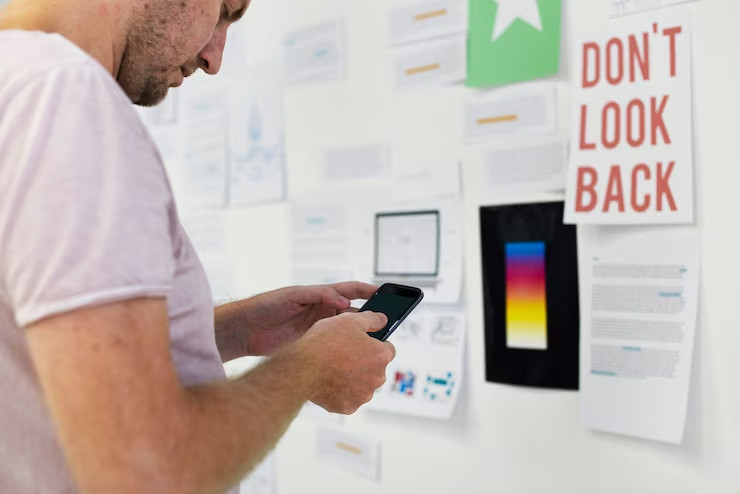Customers make purchases from businesses they trust and feel comfortable with. However, if their overall experience on your mobile website isn’t pleasant, they will likely leave and visit your competitors instead. Consider how emotionally intelligent design for mobile UX can improve user trust, comprehension, and overall conversion rate.
What does it mean to design mobile experiences that are intelligent emotionally? It means your designs should consider the emotional needs of your customers. In this blog post, we’ll look at the importance of emotional intelligence in mobile UX and offer examples of how to develop phone experiences that meet your customers’ needs.
On Mobile Devices, How To Develop Emotional Intelligence?

Emotionally intelligent design is creating products that make people feel good. This means designing intuitive, easy-to-use, and delightful products in mobile UX.
It’s not just about making a product look pretty or fun; it’s about understanding the user’s needs and creating content that meets those needs in a way that makes the user feel good about their experience.
So how do you build emotional intelligence into your mobile UX? Here are three tips:
- Natural Language Processing (NLP)
- Recognize Facial Expressions
- Physical Signal Analysis
1) Natural Language Processing
To develop emotional intelligence in your design, you must understand how users experience their emotions. This is where natural language processing comes in handy.
Natural language processing (NLP) is the ability of computers to understand language as it’s spoken or written naturally by humans. NLP allows you to analyze user interactions with your product and determine their feelings as they use it. You can then use this information to improve your product based on those emotions or even add features that evoke specific feelings in users!
2) Recognize Facial Expressions
One of the easiest ways to understand how your customer feels is by looking at their face. Are they smiling? Frowning? Their eyebrows are raised, or are they relaxed? You can tell much about your customer’s emotional states by observing them.
The first step is to understand what you’re looking for. In this case, we’re talking about emotions like anger, sadness, fear, and joy (and probably many others). Once you know what you’re looking for, it’s time to analyze the data.
3) Physical Signal Analysis
The physical signal analysis involves looking at the physical signals that your target audience uses to communicate emotion.
Suppose you’re designing a mobile app for visually impaired people who want to use it to navigate public transportation. In that case, you should think about how they might indicate their emotions while using the app. Users may tap the screen or move their fingers along the phone’s edges. They may also use gestures like waving their hands or pointing at objects on the screen. Understanding these physical signals will help create more effective interactions between the user and the device.
Best Practices For Emotionally Intelligent Design For Mobile UX

Emotionally intelligent design for mobile UX is critical in creating a user experience that people love. It’s not just about creating a pretty product; it’s about making sure your product feels right.
When it comes to mobile UX, there are a few best practices you should remember:
- Accept oversight and mistakes
- Recognize motives and biases to avoid
- Exercise empathy and a human-centered perspective
- Take feedback from your users
- Understand that interaction creates an emotional connection
1) Accept Oversight And Mistakes
When it comes to mobile UX, the first thing you should always keep in mind is that you’re not perfect. No one is. That’s why we all make mistakes, and that’s OK! Your goal should be to learn from those mistakes and improve your design process.
This isn’t just good advice for your own sake; it’s also good advice for your client. By accepting responsibility for your oversights, you can show them that they can trust you and that you’re willing to do whatever it takes to ensure they get an experience they love.
2) Recognize Motives And Biases To Avoid
You must know your biases and motives as you design a product. If you were designing a fitness app, for example, you would want to know that you might not be able to separate your desire to lose weight from the motivations of the users of the app. You can use this information to shape your design decisions and ensure the user experience is as effective as possible.
3) Exercise Empathy And A Human-Centered Perspective
This means that you should always consider how your users will feel when they use your product and their goals.
Once you’ve identified these things (and more), you need to incorporate them into your design process. One way to do this is by conducting research with real people who fit into the target market for your product or service. We can learn more about how our users think and feel and how we can make our product better meet their needs.
Read More: Learn to Build Human-Centered Design in 3 Simple Steps
4) Take Feedback From Your Users
To create a product that will resonate with your users, it’s important to take feedback from them at every stage of the process.
Ask them what they want. It’s tempting to tell users what they want, but this doesn’t involve them in decision-making. Show them prototypes early in the design process so they can provide feedback on how well it meets their needs before you’ve invested too much time and effort into something that might not work for them!
5) Understand That Interaction Creates An Emotional Connection
It doesn’t matter whether you’re designing for a mobile app or a website, the way you approach your audience is going to change depending on the medium. This can be achieved by creating a sense of community within your app through regular updates.
That’s why it’s essential to think about emotionally intelligent design for your mobile UX. Emotionally intelligent design means ensuring that users feel good about using your app, whether by ensuring they can easily accomplish tasks or helping them overcome any frustration they might be feeling.
Also read: Voice UX and VUI Design | What Designers Need to Know
Integrating Emotional Intelligence Into UX Design
Designing with EI can be tricky because it requires a lot of self-awareness and practice. But incorporating EI into your UX design process can help you create products that are more useful and appealing to users.
Here’s how:
- Create experiences that speak directly to their needs and make them want to return for more.
- Interaction between the user and the product should create a sense of comfort.
- Understanding how users feel and react to your product can create an experience that genuinely impresses them.
- Understand how best to structure interfaces to be intuitive for users.
- Understand the difference between rational and irrational thinking.
- Keep things simple and stick with what works.
Why Is It Essential To Consider Emotions When Designing?
Emotions are powerful. They can make or break experiences, which designers must consider when designing mobile UX.
When designing for mobile UX, you need to see what people feel as they interact with your app or website. You need to know how they react to different designs and layouts so that you can make sure they’re getting the best experience possible.
But how do you get inside their heads? How do you know what they’re feeling? How can you design an app that makes people FEEL something? It might sound daunting, but it isn’t—we need tips on approaching the problem.
Here are some general guidelines that can help you get started:
- Take time to ask questions. What do people want from this experience? What are their expectations?
- Be creative! Go beyond what’s already been done in this space and find new ways to engage users.
- Consider the benefits of emotional design over rational design when setting out on a new project.
Also read: Using UX to Improve Cybersecurity: The Key Part of Design
What Kinds Of Emotions Should You Consider When Designing?
When you think about your experiences with a product or service, you might consider what emotions they evoke. You might feel excited or happy when using an app or perhaps annoyed or frustrated if it doesn’t work as expected. Both these examples are positive emotions—the former being excitement (and the latter being frustration). However, negative emotions can also be conveyed through a product’s design. For example, if someone feels angry after being unable to find something on a site, the user experience may have failed.
To understand how emotional design can help improve user experience, consider what happens when these two types of emotion meet: anger and frustration! The combination of anger and frustration leads us towards aggressive behavior, which is not conducive to creating a good user experience; therefore, we want to avoid these and focus on happier ones.
Bottom Line
Should UX designers be creating an emotionally intelligent design for mobile UX? The answer to this question is a big yes! The more a designer creates a design that considers how people feel, what they deserve from this experience, and how people feel after using your product, the better you are at designing for humans. Ultimately, it’s about understanding your audience, making products to suit their needs, and ensuring that you meet user needs at every step.
By doing this and keeping in mind our points above, you’re taking steps towards EI design, which comes down to designing with users in mind. They have wants and needs. Ultimately, it’s your job as a designer to recognize them, something that is easier than you’d think!
FAQs
What Is Emotional Impact in UX?
Emotional design impacts the user first as it approximates that person’s needs and wishes and helps with the person-object interactions. It is a political and cultural tool because of its role in reforming the physicality of technology.
What Is Emotional Intelligence in Design?
Emotional intelligence is the ability to understand and manage emotions. This means that a person with high emotional intelligence can recognize their emotions and those of others and use this knowledge to make decisions.
